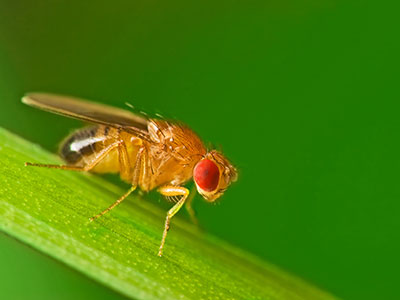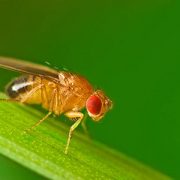Studying fruit flies to better understand human kidneys

In his latest study, Zhe Han and co-authors zeroed in on Rab genes to determine their role in fruit fly renal function.
It’s a given that fruit flies and humans are different. Beyond the obvious are a litany of less-apparent distinctions. For example, fruit flies have hemolymph instead of blood. Arranged around a single cardiac chamber, compared with humans’ four-chamber hearts, are a group of cells called nephrocytes that serve the same function as human kidneys, filtering toxins and waste from hemolymph.
But despite the dissimilarities between these two organisms, fly nephrocytes and human kidney cells are similar enough to allow the fruit fly, a common lab model that shares about 60 percent of its DNA with people, to provide insights on kidney disease in people. In a new study in fruit flies led by Zhe Han, Ph.D., principal investigator and associate professor in the Center for Cancer and Immunology Research at Children’s National Health System, researchers identified several new genes thought to be critical for renal function in humans. The findings could lend insight to the inner workings of this organ down to the molecular level and eventually help further the understanding or treatment of kidney disorders.
Han explains that recent research by his group tied 80 fruit fly genes to renal function. Many of these newly identified genes were Rab GTPases, a family of genes that make proteins whose job is to move substances around in cells through membrane-enclosed pouches called vesicles. For example, Rab proteins might put some substances on the path to destruction by moving them into lysosomes, vesicles with enzymes that break down all kinds of biomolecules. Rab proteins might help other substances be reused by steering them into recycling endosomes, vesicles that shuttle biomolecules that are still useful to where they will be used next.
In their latest study, published online Feb. 8, 2017 in Cell & Tissue Research, Han and co-authors zeroed in on these Rab genes to determine their role in fruit fly renal function. The researchers accomplished this by using genetic alterations to shut down each gene selectively in fruit fly nephrocytes. They then evaluated these transgenic flies on a number of different characteristics, including ability to effectively filter proteins from the blood, whether toxins placed in their food accumulated in their nephrocytes, how they developed and how they survived.
Their findings readily identified five Rab genes that seemed more important for these functions than the others: Rabs 1, 5, 7, 11 and 35, which all have analogous genes in humans.
Peering into the nephrocytes of flies in which these three Rabs had been silenced, the researchers made critical discoveries. Turning off Rab 7 appeared to block the path toward biomolecules in the cell entering lysosomes. Rather than biomolecules being destroyed, they instead were shuttled to the recycling route. Turning off Rab 11 had the reverse effect; recycling endosomes were drastically reduced, while lysosomes dramatically increased. Turning off Rab 5 had the most striking effect: All vesicles going in or out were blocked – like a cellular traffic jam – filling the cell with biomolecules that had no place to go, Han says.
Han, who has long tracked renal-related mutations in humans, says that no patients with kidney disease have turned up so far with Rab mutations. These genes are critical for functions throughout the body, he explains, so any embryos with these mutations are unlikely to survive. However, he adds, a host of other renal-related genes work in parallel or are controlled by different Rabs. So understanding the role of Rabs in renal function provides some insight into how these genes operate as well as what might happen when the function of these genes goes awry.
Han plans to study how Rabs 5, 7 and 11 fit into networks of renal genes as well as the role of the other Rabs that could play novel roles in the nephrocyte cell trafficking.
“These findings in fly Rabs provide the framework to study the major causes of kidney disease in human patients,” he adds.



